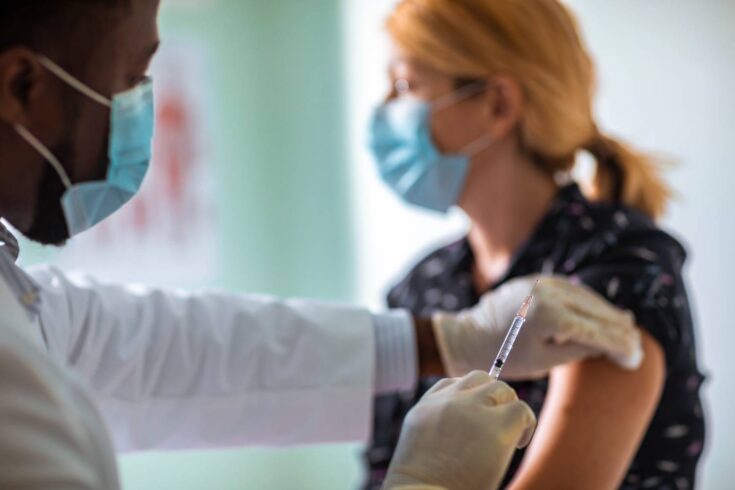The World Health Organisation declared COVID-19 a pandemic on 11 March 2020. Even before then, scientists around the world had started work on a potential vaccine.
The Oxford vaccine is based on decades of in-depth research, supported by UK Research and Innovation (UKRI) and developed by the University of Oxford and AstraZeneca.
It has been shown to be effective, safe, easily distributed and administered.
The first doses of the Oxford vaccine were administered in the UK in April 2020 as part of the vaccine’s trials.
Over two billion doses of the vaccine have now been released to over 170 countries.
The vaccine will be available on not-for-profit basis throughout the pandemic, and in perpetuity for low and middle-income countries.
The Oxford team
The Oxford COVID-19 vaccine team comprises scientists from the Jenner Institute and the Oxford Vaccine Group. It is led by:
- Professor Sarah Gilbert
- Professor Andrew Pollard
- Professor Teresa Lambe
- Dr Sandy Douglas
- Professor Catherine Green
- Professor Adrian Hill.
The team has decades of experience in vaccine research, and have been regularly funded by the Medical Research Council (MRC) and other UKRI councils.
Professor Ottoline Leyser, Chief Executive of UKRI said:
The Oxford-led vaccine team was among the first in the world to develop a vaccine candidate for COVID-19 because the team had a head start. The UK government has been investing in its vaccine research and development since before the current pandemic began.
Find out how they were able to move quickly to start developing a vaccine for COVID-19 and begin human trials by April 2020.
Video above: How did Oxford University move so fast to create a coronavirus vaccine? (Credit: UKRI). An autogenerated video transcript is available on YouTube.
How does the Oxford vaccine work?
The Oxford vaccine (ChAdOx1 nCoV-19) is made from a virus that is a weakened version of a common cold virus known as an adenovirus. This adenovirus has been genetically changed so that it cannot cause infections in humans. The team has engineered ChAdOx1 to make a specific coronavirus protein, known as the spike protein, from the SARS-CoV-2 virus.
The immune system should be able to recognise the spike protein as foreign, form antibodies and then attack the SARS-CoV-2 virus and stop it from causing an infection.
By bluffing the body in this way it is hoped that long-lasting immunity can be provided through vaccination.
The Oxford team chose ChAdOx1 as the platform for a COVID-19 vaccine as it had previously generated a strong immune response from one dose in other vaccines for similar coronaviruses like Middle East Respiratory Syndrome (MERS).
When the vaccine candidate was tested on animals by scientists at the BBSRC-supported Pirbright Institute in March 2020, the results were promising. They showed that a second dose gives a significant boosting effect compared to a single dose.
It’s also a well-studied approach to vaccine development that has been used safely in thousands of subjects.
The teams had already used ChAdOx1 vaccine technology to produce candidate vaccines against a number of pathogens including flu, Zika and MERS, another coronavirus. This was originally supported by UKRI funding from 2010.
Is the vaccine effective?
The Oxford vaccine began clinical trials in April 2020, when 1000 people were given the vaccine.
Video above: The first human trial of a COVID-19 vaccine in Europe (credit: UKRI). An autogenerated video transcript is available on YouTube.
The team has made rapid progress since the pandemic was announced and has shared data and results with the international community:
- data from the first two phases (Oxford Vaccine Group) indicated no safety concerns and a strong response to the vaccine
- in September 2020 the team reported that the vaccine provoked a strong response in older adults (Oxford Vaccine Group), who are at increased risk of severe COVID-19
- in November 2020, a peer-reviewed study of data from phase three of the trials confirmed the Oxford vaccine is safe, effectives and gives good protection
- the vaccine was found to be effective against the new UK variant in February 2021. Read more about variants.
- in February 2021, data from the trial showed that a single dose of the vaccine is 76% effective from 22 to 90-days post vaccination
- also in February 2021, the Oxford/Astra Zeneca and Pfizer vaccines were linked to a substantial reduction in the risk of COVID-19 admissions to Scotland’s hospitals.
Global rollout of the vaccine
AstraZeneca is working with over 20 manufacturing sites around the world, including the Serum Institute of India, to ensure the number of available doses continues to increase.
The company is also working with the Oxford team to ensure that technology transfer happens between the global manufacturing sites and their supply chains. This is vital, as making the vaccine is a complex process.
Sir Andy Pollard, Professor of Paediatric Infection and Immunity and Director of the Oxford Vaccine Group, said:
There is huge satisfaction and pride for the vaccine researchers, and the members of the public who took part in the trials, to have brought a billion doses of a life-saving vaccine to the world.
We also pay tribute to the superhuman efforts of the teams at AstraZeneca and Serum Institute of India who are producing a phenomenal number of doses 24 hours a day and getting them to vaccine clinics in more than 170 countries.
There is still so much to do, and all in the supply chain are pushing on knowing the next billion people are still waiting for their doses.
For more information, visit: The Oxford Vaccine (Research at Oxford).
Last updated: 11 July 2024

